Published on Egyptological, Journal Edition 4, February 27th 2012
By Kate Phizackerley
Introduction
This article is inspired by a lecture given by Professor Geoffrey Martin to the Friends of the Petrie Museum of Egyptian Archaeology (London) on 27th January 2012 about his re-excavation of King Horemheb’s royal tomb in the Valley of the Kings, tomb KV57 in the standard nomenclature. A review of this lecture by Andrea Byrnes is also published in this edition of Egyptological. Most accounts of tomb KV57 speak only of the size of the tomb and of the reliefs and largely ignore the artefacts found. Professor Martin’s talk encouraged further investigation of the artefacts found in Horemheb’s tomb. Professor Martin has had access to the artefacts from the tomb stored in the Egyptian Museum, Cairo, and is intending to publish about the contents from the tomb in the next couple of years. In the meantime, there is value in combining the information about the tomb’s contents from the two excavations, separated in time by almost exactly a century.
Discovery and Exploration of Horemheb’s Tomb
KV57 was originally excavated by Edward Ayrton for investor Theodore M Davis and published in The Tombs of Harmhabi and Touatânkhamanou(1912). The Cambridge Expedition to the Valley of the Kings under the direction of Professor Martin re-excavated the tomb between 2005 and 2009.
Some problems were unsolved until recently, including the status of the Wall Shaft inside the tomb: there was no certainty that Davis had cleared it completely. In the large undecorated chamber behind the sarcophagus hall a huge mound of debris awaited investigation. It seemed partly, at least, to consist of material deposited there by the excavators and those involved in repairing and conserving the monument at the time of the discovery and in more recent years. A tomb of such magnitude and importance clearly needed further work to ensure that all the evidence was available for a complete publication of the artefacts and an accurate section of the shaft (Martin, 2008, pp162, 163).
Edward Ayrton, on behalf of Davis, claimed to be the first to discover the tomb on 25th / 26th February 1908 (Davis 1912/2001 p2), but Professor Martin has found two graffiti in the tomb, one dated 21.5.87 [1887] and the other 1896. The tomb may have been entered up to twenty years before its official discovery and accessible artefacts removed.
Primary Sources of Information
Primary sources are severely limited. As mentioned already, the excavation was published by Theodore Davis, although his own contribution to the content was minimal. Of the section dealing with Harmhabi, as they styled Horemheb, Davis wrote an introduction; Sir Gaston Maspero contributed a lengthy and scholarly biography of Horemheb and a detailed study of the decoration of the tomb, which includes a description of the sarcophagus; and George Daressy compiled a catalogue of the contents. The watercolourist Lancelot Crane provided illustrations (reproduced in black and white in the 2011 edition).
The report also includes a set of photographic plates, mostly of the reliefs but a few plates show some of the main artefacts found. These are attributed by most commentators to Lancelot Crane but Nicholas Reeves, writing in the Foreword to the 2001 re-publication (Davis, 2001), attributes them to the renowned Harry Burton. In his talk to the Friends of the Petrie, Professor Martin implied that there was a separate set of photographs by Burton, now in the collection of the Metropolitan Museum of Art, New York: if so, they have not been published. Hopefully this will be clarified in Martin’s forthcoming report.
Well known Egyptologist Arthur Weigall was part of the small group of men who first entered the tomb and later wrote about his observations in The Treasury of Ancient Egypt.
Between 2005 and 2009 the tomb was re-excavated by Geoffrey Martin who has given a number of lectures on the topic, one of which was attended recently by the author and Andrea Byrnes who wrote up a detailed review to capture key information. Professor Martin intends to formally publish his findings comprehensively over the next year or so in combination with a re-examination of material from the Davis excavation.
A few secondary sources are useful for subsidiary points, but primary material is limited. With the exception of the sarcophagus, which is still in the tomb, there seem to be no recent or colour photographs of the other contents of the tomb. Individually and as a corpus the artefacts do not seem to have been studied since they were catalogued by Daressy for publication in 1912. Professor Martin was granted brief access to the artefacts in the Egyptian Museum when he recently examined them.
The Sarcophagus and the King’s Mummy
The pink-granite sarcophagus, measuring 2.72m x 1.15m x 1.41m (height, including the lid) (Benderitter, OsirisNet), is the largest and best preserved artefact to survive, and still resides in the tomb. The exterior texts were recorded by Maspero (Davis 1912/2001 pp 91, 95) and photographed by Crane; Professor Martin has now completed the first record of the interior texts (to be published). The lid of the sarcophagus is broken and was repaired in antiquity, perhaps when the King’s mummy was being installed. The 2005-2009 Cambridge Expedition to the Valley of the Kings lifted the lid and Professor Martin noted that the granite does not match the base of the sarcophagus, suggesting it was replaced during construction (Byrnes, 2012). The re-opened sarcophagus revealed the bones of up to three individuals, including one piece of skull. It is likely that tourists and guards have “posted” any pieces of bone they find in the tomb through the gap between the sarcophagus box and the lid, which is raised for presentation. The bones cannot be allocated to specific individuals or periods.
If the King’s sarcophagus has survived largely intact, the same cannot be said of his mummy, which is listed as missing, although bones of unknown individuals were also found by the original excavators. It is unclear whether these were left in the tomb and were rediscovered by Professor Martin, or whether he has traced bones overlooked in the original excavation.
Peering into a little chamber on the right, we saw two skulls and some broken bones lying in the corner. These appeared to be female, and one of the skulls may have been that of Mutnezem, the queen. In another small chamber on the left there was a fine painting of Osiris on the back wall; and, crouching at the foot of this, a statuette of a god with upraised hands had been placed. As we turned the corner and came upon it in the full glare of the lamps, one felt that the arms were raised in horror at sight of us, and that the god was gasping with surprise and indignation at our arrival. In the floor of another ante-chamber a square hole was cut, leading down to a small room. A block of stone had neatly fitted over the opening, thus hiding it from view; but the robbers had detected the crack, and had found the hiding-place. Here there were a skull and a few bones, again of more than one person. Altogether there must have been four bodies buried in the tomb; and it seems that the inspectors, finding them strewn in all directions, had replaced one skull in the sarcophagus, two in the side room, and one in this hiding-place, dividing up the bones between these three places as they thought fit. It may be that the king himself was buried in the underground chamber, and that the sarcophagus was a sort of blind; for he had seen the destruction caused by robbers in the tomb of Thutmosis IV., which he had restored, and he may have made this attempt to secure the safety of his own body. Whether this be so or not, however, Fate has not permitted the body of the great king to escape the hands of the destroyer, and it will now never be known with certainty whether one of these four heads wore the crown of the Pharaohs. (Weigall, 1912).
We now write the name of Horemheb’s queen as Mutnodjmet. The remnants of her mummy and canopic effects were found at the bottom of a deep shaft in Horemheb’s Memphite tomb (Martin, 1991, pp 97,98), the tomb he had prepared as a commoner before ascending the throne and coincidentally also re-excavated by Professor Martin. Queen Mutnodjmet’s disarticulated remains were found next to that of an infant. Her teeth had all been lost before death and her remains showed signs of multiple births. Wine dockets suggest her burial in the 13thyear of Horemheb’s reign (Martin, 1991, p97,98). Since Martin now believes that Horemheb reigned for only 14 years, it is somewhat surprising she wasn’t buried in his tomb in the Valley of the Kings. This Theban must have been largely complete in terms of the main passageway and chambers, if not decoration, for it to have been used for Horemheb little more than a year later. In contrast the side chambers of the Memphite tomb had never been cut and Queen Mutnodjmet was buried in a shaft, possibly driven specially for her interment. Her final repose at Memphis is more surprising if the infant buried alongside her was Horemheb’s filial heir.
Davis also found fragments of a possible coffin made from cedar wood and inscribed with the King’s prenomen. It had been covered in bitumen (resin) to preserve the wood. It is also possible it was a sledge used to transport the King’s mortal remains for interment. Daressy conjectured the existence of an inner sandstone sarcophagus from acacia wood 17cm by 4.5cm which he believed was used as a dovetail (Davis 1912/2001).
Canopic and Other Human Remains
The canopic chest and jars were cut from a single piece of alabaster which had been smashed by robbers. Davis collected various fragments from which a partial re-assembly has been made in the Egyptian Museum in Cairo. Professor Martin has found more fragments during his excavations, which he hopes might be combined into the assemblage. As well as containing canopic jars, the canopic chest was also equipped with lidded cavities to hold the embalmed intestines. Davis and his team showed a distressingly cavalier disregard for the King’s mortal remains, with George Daressy writing:
Besides these objects, there were found in the tomb of Harmhabi [Horemheb] remains of objects not worth describing: embalmed intestines wrapped in cloth to imitate a small mummy, and which must have been placed in the canopic jars; fragments of statues of men and animals in bitumenised wood; parts of caskets for statuettes or for provisions, in the form of a naos set on a sledge; covers of provision-boxes in wood, or in the form of ducks in stone; glazed-ware beads from necklaces, cylindrical or thin and wavy like the corolla of a flower; leaves of copper, torn out and bent etc. (Davis 1912/2001).
(Weigall wrote “The trained archæologist records every atom of information with which he meets; the native records nothing.” (Weigall, 1912) This statement conflicts somewhat with the records he and his peers kept: the contemporaneous records of the excavation of KV57 have many frustrating lacunae.)
There were remains of other bodies in the tomb, reported by both the original excavation and by Professor Martin during his recent clearance. As we have seen, Weigall mentioned that bones from several bodies were visible; surprisingly Maspero and Daressy ignore these in their catalogue of the tomb, and we must wonder what else they deemed unworthy of mention. Professor Martin reports that the sarcophagus contained bones of at least 3 individuals when recently re-opened, including one skull fragment (Byrnes, 2012). A single canopic jar with a human-headed stopper was found but again this may not belong to Horemheb “inscribed in hieratic ’with the name of a man … Sanoa, apparently a foreign form’” (Davis 1912/2001, p100). It is suggested, based on faint graffiti at the entrance, that the tomb served as a cache in the Third Intermediate Period (Reeves, 1996/2008, p204) so it is unclear whether the bones found belong to the original occupants of the tomb, including Horemheb, or whether they were introduced during the Third Intermediate Period.
Funerary Effects
The air was too bad to permit of our remaining long so deep in the bowels of the earth; and we presently made our way through halls and corridors back to the upper world, scrambling and crashing over the débris, and squeezing ourselves through the rabbit-hole by which we had entered. As we passed out of this hot, dark tomb into the brilliant sunlight and the bracing north wind, the gloomy wreck of the place was brought before the imagination with renewed force. The scattered bones, the broken statues, the dead flowers, grouped themselves in the mind into a picture of utter decay. In some of the tombs which have been opened the freshness of the objects has caused one to exclaim at the inaction of the years; but here, where vivid and well-preserved wall-paintings looked down on a jumbled collection of smashed fragments of wood and bones, one felt how hardly the Powers deal with the dead. (Weigall, 1912, p234).
A surprising array of funerary effects are recorded by Daressy (Davis 1912/2001, pp, 97 – 109), including:
- Fragments of a cedar wood coffin with acacia wood tenons (as mentioned above).
- Fragments of an alabaster libation altar 0.70m x 0.31m x 0.25/0.35m (length x width x height front/back) decorated with lions. Davis believes there are fragments from other libations altars and that the tomb originally contained at east four.
- Parts of two larger than life statues, 1.43m and 1.41m high, of Horemheb, fashioned in sycamore wood. Like similar statues found in Tutankhamun’s tomb the wood body of the men were painted black and the shenti garments, headdress and jewellery were gilded. In one the King is wearing the nemes headdress; fewer details are provided for the second statue.
- Bitumen-coated of a statue of Horus, 0.56m high and fashioned of cedar wood, with the necklace picked out in yellow.
- Statue of an unidentified seated god, 0.58m, fashioned of cedar wood and painted black.
- Bitumen-coated of a statue of Anubis, 0.39m high, fashioned of cedar wood and mounted on a pedestal. Interestingly parts of the bitumen had fallen off revealing that featured had been inked onto the statue beneath.
- Pedestal of a statue
- Heads of two lions and one tail. The bodies and legs are missing. The heads are made of cedar and the tail from the wood of a vine. They had been covered in bitumen but underneath the carving seems delicate. The size is impressive. The heads alone are nearly half a metre in size and the tail is 0.8m long.
- A statue of a panther. At just 0.64m long and standing 0.24m tall, it is on a much smaller scale than the lions.. Again it was coated in bitumen but Daressy noted that it was beautifully fashioned. One paw is missing. Tenons on the top indicate that it was originally ridden by a figure. The panther is illustrated in the David catalogue. It is sleek and lithe. The rolling gait is obvious and the sculptor must have personally observed panthers
- One statue of a couchant jackal, two bodies of jackals (one couchant), and two heads of jackals, all carved from cedar wood. The largely-complete statue is longer at 0.92m than the combined length of the other bodies (0.50m & 0.53m) and the heads (0.09m), even allowing for the likely golden collars which probably were the reason why they were smashed by robbers. In all cases the inlaid eyes had been stolen. The impression is of two pairs (with one couchant jackal now missing) rather than a skulk of four. The couchant statue and the two heads are illustrated in the Davis catalogue and again the couchant jackal is a piece of superior artistry.
- Heads of two hippopotamuses. One of 0.30m and the other 0.28m and both are made of cedar wood originally coated in bitumen which has now largely fallen off, and with alabaster teeth. The indication is that they were a matched pair but it is unknown whether they were statues or, for instance, were ornamentation from a couch.
- A near life-size statue of a cow carved from cedar wood and covered with little (2cm – 3cm) blue-glazed ceramic plaques. Only fragments of the cow were found. Professor Martin reports finding further plaques. (Byrnes, 2012)
- A pair of statues of hawks (≈0.43m) made of cedar wood. Unusually rather than depicting live hawks they were fashioned to resemble mummified hawks.
- A statue of a swan carved from cedar wood. Swans are now extinct in Egypt but this, and comparable finds, show that the swan was known in Pharaonic times.
- A pair of emblems of Khonsu fashioned from sycamore wood and pegged for attachment to a stand or pole.
- A Germinating Osiris made of unspecified wood.
- Two fragments of magic bricks.
- Eight small troughs made from unfired clay. Daressy believed that they were model furrows for the growth of grain. Some contained traces of have been wet.
- Mast of a model boat. The design of the boat itself is unknown but a masted model boat later found in the tomb of Tutankhamun might give a clue.
- Head of a sceptre, probably originally gilded
- Small plaque of wood, probably originally gilded. Holes along the edge indicate that it was once nailed or sewn onto something.
- Leg of a stool and two supports for a chair or chairs.
- Twelve copper roundels. Five large and one small roundels are stamped with a rosette; one large and one small roundel bear a five-pointed star.
- A headrest fashioned of acacia wood. This shows a high standard of carpentry. It was made of two parts joined by a tenon with pegs to keep it in place. The heads of the pegs were inlaid with ivory to that the pegs themselves were not visible.
- Two alabaster ointment(?) vases 0.09 and 0.16m high
- Support for a light, round-bottomed vase, fashioned of rushes.
- Small copper cup – 0.010m diameter at the top and 0.04 at the bottom, it stood 0.048 high
- Embalmed intestines wrapped in cloth (possibly originally placed within a canopic jar).
- Further fragments of men and gods – bitumenised wood.
- Parts of caskets.
- Glazed beads (probably from a necklace).
- Leaves of copper, torn off something and bent
- “Etc.” – which is frustrating because we know from that usage that items were found but not recorded.
The purpose of this paper is to list the contents to combine them with the list of objects found a century later by Professor Martin, and to drew attention to a few. For a fuller description of the objects, please refer to the The Tombs of Harmhabi and Touatânkhamonou. Only a few are illustrated. They are now stored the Egyptian Museum, Cairo, although it is unclear whether all the items found were kept.
Professor Martin has been able to add to this list at least the following:
- Wood with blue inlays
- “A lot” of blue glass inlays
- A dozen notched array heads 0.2m – 0.23m long
- Items of shabti equipment including hoes. No shabti themselves are known to have come from the tomb, but they must have existed. A calcite shabti found in nearby KV58 (Phizackerley, 2011) has however not been attributed, while more likely to have belonged to Ay, it could have been one of Horemheb’s. The shabti itself is on display in the Egyptian museum; Lancelot Crane’s watercolour is in the collection of the Metropolitan Museum of Art, New York.
- Bronze nails
- Lotus-shaped clips
- A scant number of pottery sherds. (Martin suggests that potsherds were discarded by Davis / Maspero when the tomb was originally excavated.)
- A lot of beads in various colours
- Fragments of a quern and of sandstone grinders
- Fragments of several seal impressions including the Seal of the Royal Necropolis depicting Anubis and nine prisoners
- A jar stopper
Possible Items in Other Collections
A few items believed by Nicholas Reeves to have come from Horemheb’s tomb (Reeves, 1996/2008 p133) also leaked onto the market and are in the British Museum. Professor Martin suggests that these were probably taken from the tomb before discovery by Ayrton (Byrnes, 2012), but there are reasons why this is problematic.
The torrents of rain which sometimes fall in winter in Egypt percolated through this filling, and left it congealed and difficult to cut through; and on the top of this hard mass tons of rubbish were tossed from other excavations, thus completely hiding the entrance.
And …
After a few weeks of digging, the mouth of a large shaft cut into the limestone was cleared. This proved to lead into a small chamber half-filled with rubbish, amongst which some fine jewellery, evidently hidden here, was found. This is now well published by Mr Davis in facsimile, and further mention of it here is unnecessary. Continuing the work, it was not long before traces of another tomb became apparent, and in a few days’ time we were able to look down from the surrounding mounds of rubbish upon the commencement of a rectangular cutting in the rock. The size and style of the entrance left no doubt that the work was to be dated to the end of the XVIIIth Dynasty, and the excavators were confident that the tomb of either Tutankhamon or Horemheb lay before them. Steps leading down to the entrance were presently uncovered, and finally the doorway itself was freed from débris. (Weigall, 1912, pp227, 228)
This description indicates that the tomb entrance was inaccessible immediately before clearance, although this account is contradicted by the graffiti dated 1887 and 1896 observed by Professor Martin (Byrnes, 2012). It is therefore uncertain whether several portable artefacts were looted from the tomb at the end of the 19th Century / early 20th Century, or whether lax security organized by Davis allowed objects to go missing during the official excavation. Artefacts may instead have been moved in antiquity to a different tomb from which they were looted at the turn of the 19th Century.
The Louvre, for example, owns a signet gold ring of Horemheb (Rigault, undated). Purchased in 1835 it cannot have come from KV57 in modern times unless the tomb in the Valley of the Kings was entered much earlier than presently identified. How it might instead have reached the market is unknown, but at the least there are grounds to question whether Ayrton, acting for Davis, was indeed the discoverer of the tomb in 1908.
The Metropolitan Museum of New York catalogue (see bibliography) also lists a fragment of alabaster furniture possibly from Horemheb’s tomb, donated by Theodore Davis himself. It would be easy to overlook the alabaster fragment in the Metropolitan Museum; I am uncertain whether there might be items in other collections which I missed when researching this article.
Wine Jars
Professor Martin recovered fragments of at least 92 wine jars from the well shaft (Martin, 2008, Byrnes 2012). Many of the dockets bear inscriptions from Year 13 and Year 14. The latest year recorded on a wine docket in Queen Mutnodjmet’s Memphite burial was also year 13. (Martin, 1991, p09) There is a groundswell of support for the recognition of a reign length of 13 years (or just into the 14th year), much reduced from the previous accepted reign length of 27 years. The topic merits future discussion in a dedicated article.
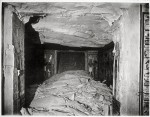 |
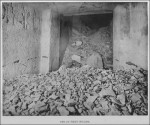 |
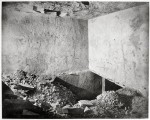 |
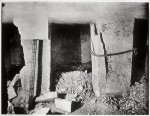 |
Conclusion
Horemheb’s tomb originally contained an array of treasures very similar in style to those found in Tutankhamun’s tomb by Lord Carnarvon and Howard Carter. Lacking a complete inventory of Horemheb’s burial, we will never know if his burial was more lavishly appointed than Tutankhamun. Reeves believes that the Tutankhamun assemblage was less than that provided to long-lived pharaoh buried in large tombs (Reeves, p125). If Reeve’s theory is correct, Martin’s proposed reduction of the recognised reign length for Horemheb to 13 or 14 years, only a few years more than that of Tutankhamun, would suggest that Horemheb may have been buried with not a great deal more effects than Tutankhamun.
Setting aside consideration of the extent of the inventory, the close similarities between the objects found in KV57 and Tutankhamun’s KV62 allow us to imagine the contents of Horemheb’s tomb in their original splendour. The style of the contents of Tutankhamun’s tomb is consistent with objects found in the burial of Horemheb, who worshipped Amun, and indeed suppressed the memory of Atenistic Pharaohs like Ay. The superficial conclusion of such a comparison reinforces the view that Tutankhamun’s burial was in the traditional style without overt trappings of Atenism.
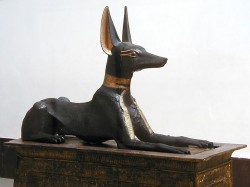 |
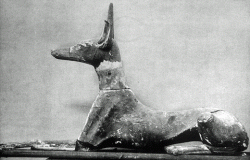 |
It is possible that if the bitumen was removed from some of the objects from KV57, and they were carefully conserved, the revealed wooden statues would be every bit as good, perhaps even superior to, those found in Tutankhamun’s tomb. The similarities between the jackals is compelling. Scant imagination is also needed to compare the KV57 panther, for instance, with the famous figure of Tutankhamun on a panther, which was sadly damaged in the 2011 robbery from the Egyptian Museum, and a pair of similar panthers found in the tomb of Amenhotep II. The presence of the panther in all three tombs suggests that the panther was a “stock” item onto which the statue of the relevant king was added. Reeves has suggested that several items in Tutankhamun’s tomb were re-inscribed for his use (Reeves, 1990, p169) and several commentators believe his funerary effects incorporated a number of recycled items. While there is no proof that it happened, without very detailed study we would be unaware if the statue of the King had been substituted for an earlier one on composite pieces like that of the King riding the panther. A detailed comparative study of the artefacts found in the two tombs may advance our knowledge not just of burial practices, but of the history and significance of particular items. When certain Tutankhamun statues were repaired after the Egyptian Revolution in 2011 we should hope that very detailed photographic records of the conservation were kept which might offer additional insights into their original construction from constituent components.
It is disappointing how poorly the tomb was excavated and documented by Davis and his team. Professor Martin has indicated a wish to catalogue the objects in the Cairo Museum. That is a long-overdue exercise. If Martin publishes a catalogue with images then it should provide an invaluable resource for those interested in learning more about the contents of New Kingdom tombs. If Reeves is correct that further wooden objects in the British Museum should be attributed to the tomb of Horemheb (Reeves, 1996/2001 p132,133) , then might there be further items whose provenance is yet to be recognised?
Bibliography
Benderitter, Thierry, OsirisNet, Horemheb KV57, http://www.osirisnet.net/tombes/pharaons/horemheb/e_horemheb_part1.htm and http://www.osirisnet.net/tombes/pharaons/horemheb/e_horemheb_part2.htm
British Museum Online Catalogue, Wooden Figures possibly from KV57, http://bit.ly/wN65ai (web link checked 22/2/2012)
Byrnes, Andrea, Lecture Review: The re-excavation of the tomb of Horemheb in the Valley of the Kings by Professor Geoffrey Martin, Egyptological Magazine, Edition4 February 2012, /?p=7484
Davis, Theodore M., Gaston Maspero, Georges Daressy and L. Crane. The Tombs of Harmhabi and Touatânkhamonou, London, 1912. (Reprinted 2001, Duckworth)
Rigault, Patricia, Louvre Online Catalogue, Ring of Horemheb, http://www.louvre.fr/en/oeuvre-notices/ring-horemheb, (web link checked 23/2/12012)
Marin, Geoffrey, The Hidden Tombs of Memphis, London 1991
Martin, Geoffrey et al, Tenth International Congress of Egyptologists, University of the Aegean Rhodes, 22-29 May 2008, http://www.rhodes.aegean.gr/tms/Abstracts.pdf
Metropolitan Museum of New York Online Catalogue, Alabaster Furniture Fragment possibly from KV57, http://www.metmuseum.org/Collections/search-the-collections/100023010?rpp=20&pg=1&ft=Kv57&pos=9 (web link checked 23/2/2012)
Phizackerley, Kate, Picture Wanted: KV58 Shabti (CCG 60472), Egyptological – In Brief, May 2011, /2011/05/picture-wanted-kv58-shabti-ccg-60472-3622
Reeves, Nicholas, The Complete Tutankhamun, London 1990, references from the 2007 edittion
Reeves, Nicholas, and Wilkinson, Richard H, The Complete Valley of the Kings, London 1996, references from paperback edition reprinted 2008
Weigall, Arthur E. P. B., The Treasury of Ancient Egypt – Miscellaneous Chapters on Ancient Egyptian History and Archaeology, Chicago and New York 1912 (reproduced by Juliet Sutherland, Peter Barozzi for Project Gutenburg, 2005, ISO ISO-8859-1, http://www.gutenberg.org/ebooks/16160). (The text relating to Horemheb was replicated in the 1923 book, The Glory of the Pharaohs.)
Image Credits
Black and white photographs of KV57, Burton, Harry, c1908, out of copyright
Couchantjackal from tomb of Tutankhamun, © Bodsworth, Jon, used with permission
Horemheb Ring, Louvre, © Déschcamps C, used under Louvre non-commercial access licence
Queen Mutnodjmet’s canopic jar from Horemheb’s Memphite tomb (British Museum), © Phizackerley, Kate, 2009
Well chamber in KV57, © gabindu, 2009, Creative Commons via http://www.flickr.com/photos/gabindu/3737502608/sizes/s/in/photostream/
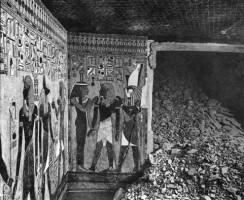
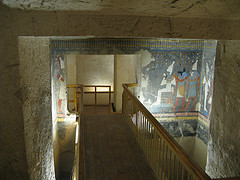
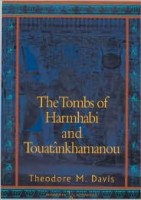
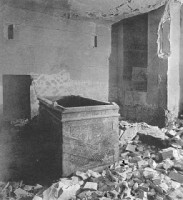


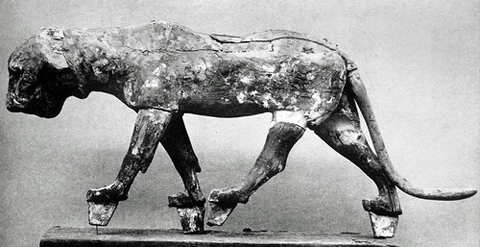

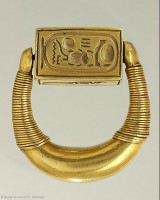
 By
By